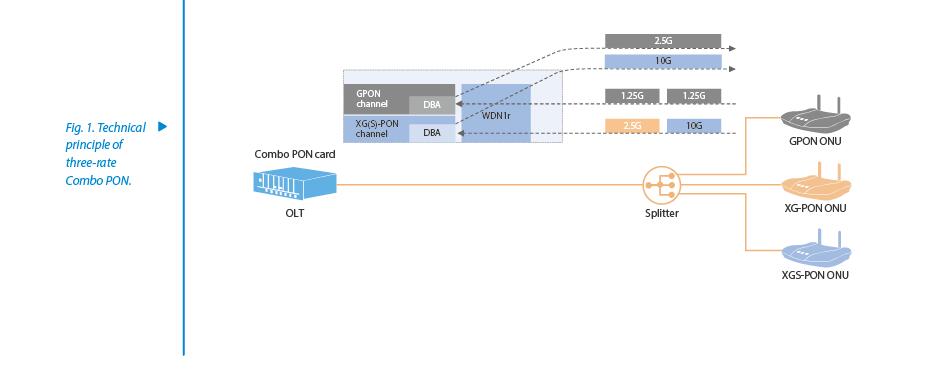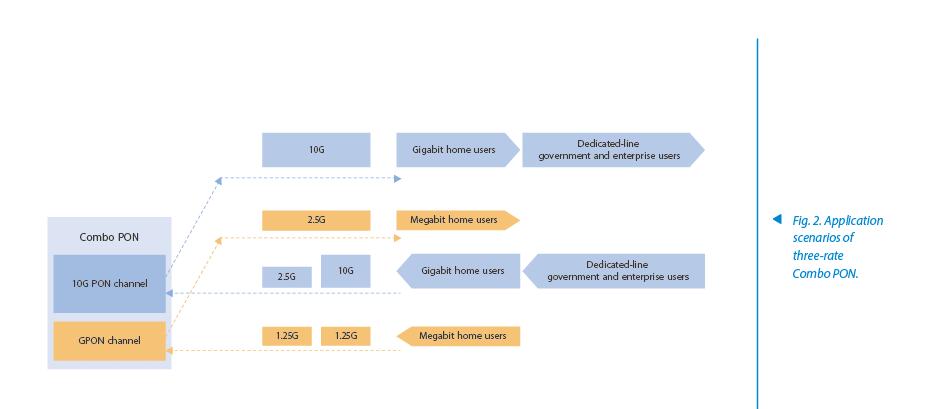Three-Rate Combo PON Leads the Trend in 10G GPON Deployment
In China, 100M fiber broadband has become popular, and the gigabit era is about to begin. China's Ministry of Industry and Information Technology (MIIT) launched the "dual-gigabit acceleration, same speed for same network" initiative in 2019 to promote fixed broadband gigabit applications. 10G GPON is the technology of choice to propel China's fixed broadband from megabit into gigabit rates. 10G GPON encompasses a range of technologies including XG-PON, XG-PON&GPON Combo, XGS-PON, and XGS-PON&GPON Combo. The evolution to 10G GPON needs to consider the compatibility with various in-service ONUs.
To solve the incompatibility of XG-PON and GPON ONUs, ZTE has proposed the innovative Combo PON technology to enable XG-PON&GPON Combo. This two-rate Combo PON technology has found popularity with operators because of its good compatibility and great ease of use. It has become the primary solution for 10G GPON deployment, and has been put into large-scale commercial use.
Currently, the XGS-PON technology has also matured. XGS-PON can provide 10G symmetric bandwidth, but XGS-PON OLTs are only compatible with XGS-PON and XG-PON ONUs. However, a large number of GPON ONUs are deployed in the existing networks. That means when the networks evolve to XGS-PON, they must be compatible with GPON ONUs. To solve this problem, ZTE has proposed the three-rate Combo PON technology to combine XGS-PON and GPON and enable smooth evolution from GPON to XGS-PON.
Technical Principle
XGS-PON&GPON Combo PON is a built-in optical multiplexing solution that supports the coexistence of XGS-PON, XG-PON, and GPON. It is also called "three-rate Combo PON", and is recognized in the industry as the best solution for smooth upgrade from GPON to XGS-PON.
Because XGS-PON and GPON use different wavelengths, three-rate Combo PON multiplexes the two wavelengths in an optical module, thereby achieving separate transmission and reception of GPON and XGS-PON optical signals. The three-rate Combo PON optical module has an embedded multiplexer, called the WDM1r, to combine and divide four upstream and downstream wavelengths needed by XGS-PON and GPON. XGS-PON and XG-PON use the same 1270 nm upstream and 1577 nm downstream wavelengths, while GPON uses the 1310 nm upstream and 1490 nm downstream wavelengths. The three-rate Combo PON optical module implements the transmission of four wavelengths over a single fiber (Fig. 1).

Three-Rate Combo PON Solution
ZTE's three-rate Combo PON card has 8/16 ports. One port corresponds to two PON MACs (GPON MAC and XGS-PON MAC) and two physical channels. In the downstream direction, after two wavelengths are processed at separate PON MACs, they are sent to the optical module for multiplexing and then sent to different ONUs. XGS-PON ONU receives the XGS-PON signal, XG-PON ONU the XG-PON signal, and GPON ONU the GPON signal. In the upstream direction, GPON and XGS-PON use different wavelengths, which are first filtered in the optical module and then processed in different PON MACs. XGS-PON and XG-PON use the same wavelengths and require dynamic bandwidth allocation (DBA) scheduling in the same channel.
On the Combo PON card, the 8/16 ports are numbered to facilitate the operation and maintenance (O&M) of the OLT as well as the interconnection between the EMS and resource management system. When configuring data on the EMS, a new card type needs to be added. GPON ONU, XG-PON ONU and XGS-PON ONU are numbered in a unified manner, so that the OLT can automatically identify the ONU type and assign corresponding channels. Since one three-rate Combo PON port corresponds to both the GPON and XGS-PON physical channels, its O&M has the following characteristics:
—As one Combo PON port has two physical channels: GPON and XGS0PON, its management information bases (MIBs) must have additional performance statistics and alarm management information.
—Previously, the information of the GPON and XGS-PON channels was obtained separately, but is now gained simultaneously.
—The MIBs related to other service configuration and O&M remain unchanged.
Advantages
Three-rate Combo PON supports the access of XGS-PON, XG-PON and GPON ONUs, allowing operators to meet the requirements of different customers. XGS-PON ONUs can offer private-line access for government and enterprise private-line users, XG-PON ONUs can provide gigabit access for home users, and GPON ONUs can deliver megabit access for home users (Fig. 2).

—Easy deployment without any adjustment to ODN. The traditional PON solution needs an external optical multiplexer and the ODN has to be greatly adjusted. This would result in considerable engineering difficulties. By contrast, three-rate Combo PON employs an embedded multiplexer and requires no adjustment to ODN when it is compatible with the in-service GPON ONUs.
—No new insertion loss introduced. The issue of optical power margin can be completely addressed. An external multiplexer might add 1–1.5 db insertion loss, which would strain the already tight optical power budget of many existing networks and make the new multiplexer unfeasible. Three-rate Combo PON does not cause extra insertion loss. Using the same-class optical module, the Combo PON does not change the optical power budget margin of the ODN.
—Small footprint and simple O&M. The three-rate Combo PON optical module integrates XGS-PON, GPON and WDM1r functions, and needs no additional equipment or extra room space. This simplifies equipment O&M.
—Easy interconnection with OSS and fast service migration. Three-rate Combo PON uses the wavelength division mode. The XGS-PON and GPON channels automatically match their ONU types and can use the existing interconnection with OSS. The service provisioning process is unchanged and services are easy to migrate.
The three-rate Combo PON solution has attracted high attention from mainstream operators worldwide like Orange, Telefonica and China Mobile. ZTE is actively participating in the three-rate Combo PON tests and commercial trials with operators, leading the trend in 10G GPON deployment.